Picture yourself at a busy pedestrian crossing. When the light is red, everyone waits—until one person starts to cross. Soon, others follow, and eventually everyone follows the crowd and crosses. Amsterdam physicists have discovered that a very similar process happens at the microscopic level, when two touching surfaces start to slide. Their results were published in Physical Review Letters this week.
In their experiment, Liang Peng, Thibault Roch, Daniel Bonn and Bart Weber pressed a smooth silicon surface against a rough one. The researchers, from the University of Amsterdam and the Advanced Research Center for Nanolithography, then explored how the friction behaved when the strength with which the two surfaces are pressed together was varied. Does it get harder to slide the two surfaces along one another when one presses harder? And, importantly: why?
